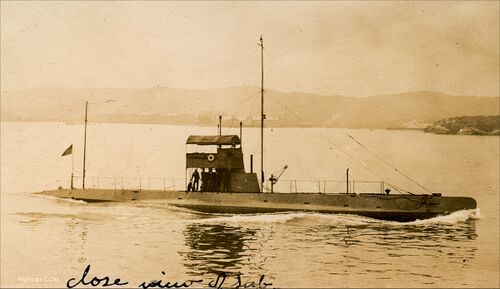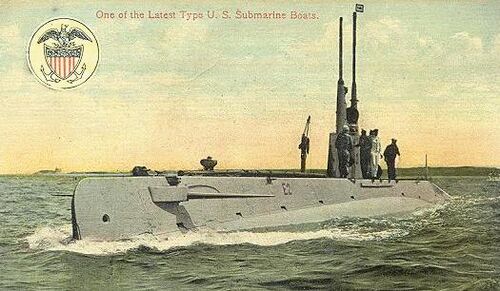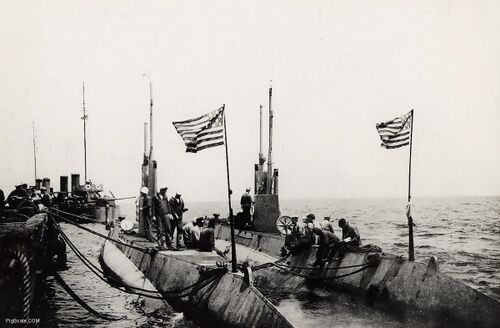E-class: Difference between revisions
Pbcjohnston (talk | contribs) →Design, Construction, and Naming Notes: Rewrote the Notes section |
Pbcjohnston (talk | contribs) |
||
| Line 17: | Line 17: | ||
</div> | </div> | ||
[[File:E-1 underway-2.jpg|left|500px|Photo in the private collection of Ric Hedman]] | [[File:E-1 underway-2.jpg|left|500px|Photo in the private collection of Ric Hedman|alt=submarine E-1 underway in the Azores in the summer of 1918]] | ||
<div style="text-align: justify;"><span style="color:#00008B">The E-1 is seen here at an unidentified location, possibly Ponta Delgada, Azores, summer 1918. E-1 was a pathfinder, the first USN submarine with bow diving planes, seen here folded up alongside the forward superstructure. The bow planes were used to keep a precise depth, and the stern planes were used to control the up or down angle while running submerged. The E-class boats were also the first to have diesel engines. In this photo E-1 is either starting or finishing a long surface run, evidenced by the extensive bridge structure and the tall radio masts. All of this topside clutter would have to be disassembled and stowed below before the boat could dive, a process estimated to take at least 45 minutes.</span> | <div style="text-align: justify;"><span style="color:#00008B">The E-1 is seen here at an unidentified location, possibly Ponta Delgada, Azores, summer 1918. E-1 was a pathfinder, the first USN submarine with bow diving planes, seen here folded up alongside the forward superstructure. The bow planes were used to keep a precise depth, and the stern planes were used to control the up or down angle while running submerged. The E-class boats were also the first to have diesel engines. In this photo E-1 is either starting or finishing a long surface run, evidenced by the extensive bridge structure and the tall radio masts. All of this topside clutter would have to be disassembled and stowed below before the boat could dive, a process estimated to take at least 45 minutes.</span> | ||
Revision as of 17:56, 18 December 2024

Design, Construction, and Naming Notes
The rapidly increasing size of USN submarines was showing that the typical single set of stern diving planes was becoming inadequate for underwater control. A second set of planes near the bow would provide precise depth control while the stern planes would continue to provide angle control. Grayling of the D-class had experimented with the concept and it proved to be entirely successful. The E-class boats would be the first submarines in the USN to be equipped with bow diving planes as standard equipment.
These two boats were originally named Skipjack and Sturgeon. On November 17, 1911, after launching but prior to being commissioned, the Navy changed its naming convention for submarines and these boats received their E-class names. Both boats were redesignated from their original general submarine designations to the new SS series on July 17, 1920.
E-2 suffered a serious battery explosion and fire on January 15, 1916 while undergoing tests on a new battery type at the Brooklyn Navy Yard near New York City. Unfortunately, four men were killed and seven were seriously injured. For a better explanation of this incident, please see the Notable Submarine Accidents page for more information.
Skipjack/E-1 (Submarine No. 24, later SS-24)

Sturgeon/E-2 (Submarine No. 25, later SS-25)

General E-class Photos

See more General E-class Photos
Page created by:
Ric Hedman & David Johnston
1999 - 2023 - PigBoats.COM©
Mountlake Terrace, WA, Norfolk, VA
webmaster at pigboats dot com